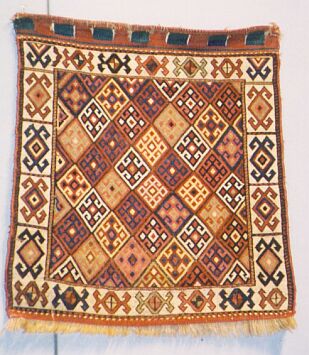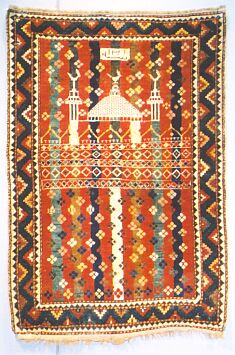
The Salon du Tapis d'Orient is a moderated discussion group in the manner of the 19th century salon devoted to oriental rugs and textiles and all aspects of their appreciation. Please include your full name and e-mail address in your posting.
Part 2 of:
A Trunk Full of My Favorite Things: A "Rug Morning" with Joe Fell
by R. John Howe
Joe indicated that the piece below is one that he has thought was Tekke (the red ground elem version of this design ,"kizil", is seen as less frequent than those with with white ground elems, described as "ak") .

He said that Elena Tzareva has indicated that this chuval may be "middle Amu Darya," but that she is not sure. The next, piece, Joe offered, was a large chuval(?) face, that he said that he has been calling "Kyrgyz."

Richard Isaacson suggested from the audience that this is a piece that it would be better to describe as from the middle Amu Darya area. The next piece is one that you have seen before, since it was in Jerry Silverman's ACOR exhibition.

This piece is one of my personal favorites, described as a compartmented "tulip" design. The next piece, a Kyrgyz bag face, was also in Jerry's ACOR exhibit and, I think he said, attracted some comment as perhaps the most unusual piece in it.

Joe said that some call this a "sun and moon" design and some see it as a kind of "garden." There are two other published examples, one being a main carpet of some size. He said that his acquisition of it suggests that it is sometimes important for collectors to be patient. He said he first saw this piece at the apartment of a Chicago couple and offered to buy it. They did not want to sell at that point. A few years later, the wife came to Joe's shop saying that they wanted to buy an oriental rug for one of their children. Joe said he put out 30 examples for her to consider. She liked several but said to Fell that they couldn't afford any of these pieces. Joe said, "Take any one of them. I don't want any money. I only want in trade that little bag face that you have." That, Joe said, is how he ultimately acquired this piece. Wendel Swan immediately spoke up, with a smile, saying, "Joe, how many of those rugs you offered this lady were chenille?" Great fun.
The next piece had an unusual shape and design.

Joe said that this piece has been something of a puzzle to him. It seems too large to have been a saddle cover excepting perhaps for a very large animal like a camel. He said that he has conjectured that it is likely from East Turkestan. Harold Keshishian offered from the audience that these pieces are called "sonic boom" rugs, in the trade, because of their field design and that the ones he has seen usually have a "wedge" shape at the corners rather than the rounded one that appears here. About a week after Mr. Fell's talk, I encountered a very similar piece in George O'Bannon's little survey book, "Oriental Rugs," (1995). On page 63 George offers the image below.

Notice that this rug also has rounded corners. Here's what O'Bannon says about it. "Khotan rug, 2 ft. 11 in. s 5 ft. 8 in., c. 1800. The exact use of this unusually shaped rug is not known. The patterns at the ends are waves and mountains. Eight cloud patterns surround the fret medallion in the field. The red color of this rug is unusual both for Chinese and East Turkestan rugs." I have encountered since one other instance of this field design, that is an actual saddle cover shape and size.
The next piece was an unusal hooked rug.

Mr. Fell asked if anyone knew what it might be made from. I had just done some digging about a little hooked rug I had bought and so had some basis for saying that there were some hooked rugs made from women's stockings and undergarments. Joe confirmed that that is the sort of material from which this rug was made. They were, I said, called "Grenfells," and were made in Newfoundland. I got some of the rest of it wrong (e.g., although there was a "Grenfell" label, there was never a company. Grenfell was a cottage industry started by a medical missionary and the pieces were made in their homes by the wifes of fisherman and sailors), but afterwards corrected things by putting Joe in touch with Paula Laverty, the lady who has posted on Turkotek who has the Grenfell web site: Here's what she said when I sent her an image of Joe's piece: "It is indeed a Grenfell and a nice one at that. It is the map of Newfoundland showing the Grenfell hospitals and nursing stations. It looks to be stained on the right, near St. John's. This mat was the most common one produced and was in production by the mid 30s…Was there a label on the back?… I assume it was around 38" x 32?" Here, in case you missed it last time is the link to Ms. Lavarty's site on Grenfells.
The next piece was, I think, also in Jerry's ACOR exhibition.

This is a Shahsavan sumak khorjin bag face. Joe said that at one time he owned both halves of this khorjin, but that he had separated them and sold one to Wendel Swan. A very similar complete khorjin set was published as Plate 113 in the 1996 ICOC "Atlantic Collections" catalog. Wendel pointed out from the audience that this is a quintessential Shahsavan design.
The following piece is a side panel from a Shahsavan mafrash (cargo bag).

The next piece was another Shahsavan mafrash side panel. I couldn't quite avoid Joe's arm.

Joe next put up a very unusual yastik.

The suggestion was that this piece might be from the Kisehir area, but the basis for that was not given. There are some yastiks without borders, but there is nothing that seems to me to be remotely like this piece in the Morehouse volume. The next piece was a more conventional-seeming yastik.

Joe felt that this piece is Kurdish. There was also comment suggesting that the design might be of "stylized water fowl in a fountain" or that, perhaps, the two field major devices were "derived from Kurdish eight-point medallions."
The piece below is a South Persian saddle bag, complete with its back.

It is said the be Qashqai and the front is the most unusually colored Qashqai bag of this sort that I have ever seen. Usually they are very dark colors. And the back on this piece is wonderfully colorful.
This piece will appear in the South Persian exhibition at ICOC X. This was described as a Jaff Kurd bag face done in reverse sumak.

There may well be that the Jaf Kurds wove this design in flatweave as well as pile but the flatwoven pieces I have seen with this design are usually said to be woven by Khorosan Kurds.
The piece below is a Caucasian bag face from the Lenkoran area. This is another piece that Jerry Silverman selected for his ACOR 6 exhibition.

Notice the nice navy blue ground and the five animals. Joe said that he especially likes the animals in the Luri/Baktiari bag face below.

There are both leopards and camels. This piece is a favorite despite the presence of some synthetic dye.
The last piece Mr. Fell presented this morning was a Balouch bag face with a mina khani design in the field.

Note the naturalistic drawing of the petals of the white flowers.
Some participants had brought pieces in. I have included one of them below because it was both colorful and quite unusual. The piece was estimated by those in the room to be Caucasian, perhaps Kazak.

Unusual for a Caucasian piece, it has a drawing of a mosque in its field. It is also dated, 1311, that's about 1893.
The session ends and the conversation starts up as it always does, this morning first between Joe Fell and Harold Keshishian.

Thanks, Joe. We first saw your session on the schedule a year ago, but it was worth waiting for.
Regards,
R. John Howe